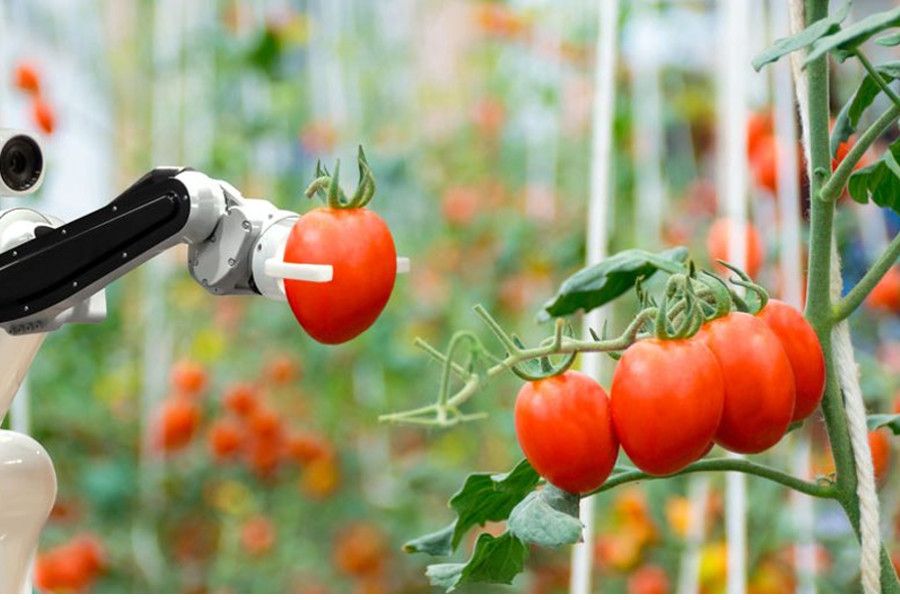Allianz Global Risk Dialogue: I, Cobot

Collaboration is key in the workplace. And cobots – ‘collaborative robots’ - are very good at it. Relieving humans of repetitive tasks, these bots are doing everything from topping your pizza to inspecting aircraft. Who are they and what can we expect from them?
The pizza base is ready, the melted cheese bubbling away. A dash of sauce, a toss of toppings and it’s good to go. Right into a home where a cozy group of football fans is waiting.
A good meal deserves to be followed by compliments to the chef. But not in this case. The ‘chef’ doesn’t have any ears. You see, it’s a cobot – a ‘collaborative robot’– that’s putting together the pizza, one after another, exactly how it has been programmed to do.
Designed to rescue humans from the boredom and even health implications of repetitive tasks, cobots are proliferating in production facilities across industries including food.
They are planting and trimming lettuce, plucking and sorting apples, oranges and strawberries, packing meat, sprinkling ingredients on food items, putting eggs in cartons and even checking produce quality.
Not far behind in employing are industries such as automobiles, electronics, life sciences, logistics, chemicals, pharmaceuticals, space and military. Their range of tasks are as diverse as lifting, moving and placing heavy objects to inspecting aircraft. Rolls-Royce is working with academicians to develop insect-like cobots that can help shrink the time needed to maintain aircraft engines to minutes from hours.
Why cobot?
So why do we need cobots? Because they can automate and speed up repetitive processes that often cause musculoskeletal injuries among humans, deliver more consistency in performance, work non-stop and enter areas that could be uncomfortable for humans.
Also, they are easier to work with than standard robots.
Unlike a traditional robot, a cobot can be programmed and installed quickly; in some cases, within half an hour! They are also fast learners, going from one kind of task to another and hopping from one department to another as soon as the settings change.
This makes them as flexible as human workers but with a lot more consistency and accuracy in repetitive tasks. For example: A cobot will apply exactly the same pressure while tightening a screw, even if it has to do it a thousand times. Even the most skilled human worker cannot deliver such consistent precision.
Will the cobot steal a human’s job? Highly unlikely. It makes a good servant, not a good boss. You need human workers to control, program, correctly deploy and monitor cobots. Freed from repetitive tasks, humans can focus on improving processes and products, channeling their energy into tasks that need creativity and thinking.
“A cobot can roll the dough and put toppings on it. Can it handle a customer complaining that there is too little cheese on the pizza? Probably not,” says Oliver Lauxmann, an expert from Allianz Global Corporate & Specialty, the corporate insurer of the Allianz Group. According to him, trained employees are key to the value of cobots.
Industries that have a shortage of labor particularly stand to benefit from cobots. For instance: faced with an aging workforce, Japan has turned to these machines for its construction sites as it loses workers to retirement.
Little helpers
Cobots were first developed in the 1990s by Northwestern University professors J Edward Colgate and Michael Peshkin at the behest of General Motors. The iconic U.S. automaker felt the need for machine hands on deck as repetitive stress injuries among workers resulted in lost productivity. In 1999, the cobot was patented, officially coming into being.
Since then, its adoption has grown leaps and bounds.
In 2018, the market for cobots stood at nearly $600 million, rising from below $400 million the year before. This is expected to reach or even top $7.5 billion by 2025. In the coming year, more than 40,000 cobots will join the workforce, with Germany, the UK and France leading the charge, followed by North America.
The most popular are the light-to-moderate cobots, with capacity to lift 5-10 kilos. Small and medium enterprises (SMEs) are especially fond of cobots. With good reason: at a relatively low average cost of about $24,000 each, they can help SMEs better compete with large manufacturers.
“A cobot is a good investment for a manufacturer because it is less costly, safer and more efficient than standard robots,” adds Oliver. “It can help increase performance and revenue.”
What's the catch?
Everything has a good side and a bad side. Cobots are no exceptions to this rule.
When dealing with machines, safety is a legit concern. “Workers and consumers who come in contact with cobots understandably have reservations about safety, benefits, behavior, etc. But if the benefits outweigh the risks, then acceptance will widen,” says Oliver.
That said, accidents involving cobots are rare. A stray incident was reported in 2016, when a roving security cobot at a California shopping center bumped into a toddler, knocking him down and running his foot over.
However, even one accident is too many.
Well-defined regulations are needed to keep the peace between man and machine. As the idea is at a nascent stage, regulations are yet to be developed and standardized but some countries have moved on it.
In Germany, for example, there are guidelines to protect humans. These include topics such as manual guidance, on humans controlling cobots; speed and distance monitoring, on contact between a human and a moving robot being prevented by the machine; safety-related, supervised standstill, on cobots ‘freezing’ in place if a human comes into its immediate space; and power and force limitation, on contact force between a human and a cobot being technically limited to a safe level.
In the future, we might see cognitive cobots that can sense obstacles and adjust their speed or reverse to avoid crashing into objects, handle unforeseen situations even in complex environments and improve their behavior through learning.
Some other factors hindering the large-scale adoption of cobots are privacy concerns, the threat of cyberattacks, and fears of technical glitches. Cobots equipped with cameras and controlled via servers can trigger questions about privacy, while risk of cyberattacks always looms over programmable tools. A technical glitch could prove rather costly if companies have to recall a product because of quality issues introduced by a malfunctioning cobot.
Source of information
Allianz & ProfiBusiness.world
Date
October 11, 2019
Fotogalerie
Translator
ProfiBusiness.world
News and information
Agriculture
Animals and pet supplies
Automotive
Banking and insurance
Boats and shipping industry
Building and architecture
Business
Education
Electrical industry
Electronics
Engineering
Environment
Finance, taxes and accounting
Flowers and plants
Food and beverage industry
For companies
Forestry and wood processing
Furniture
Gastronomy and hotel industry
Glass, ceramics and porcelain
Healthcare and pharmacy
Hobby and garden
Home and household goods
HR
Hygiene, drugstore and cosmetics
Charity and social responsibility
Chemical
Institution
IT and computers
Law and legislation
Management and certification systems
Minerals
Office
Packaging and packaging technologies
Paper industry
Plastic and rubber industry
Power engineering
PR and marketing
Printing and printing technology
Railway industry
Real estate
Safety, security and protection
Science and research
Social services
Sport and relax
Steel and iron processing
Telecommunications and the internet
Textile and leather industry
Tourism
Toys, games and entertainment
Transport and logistics




